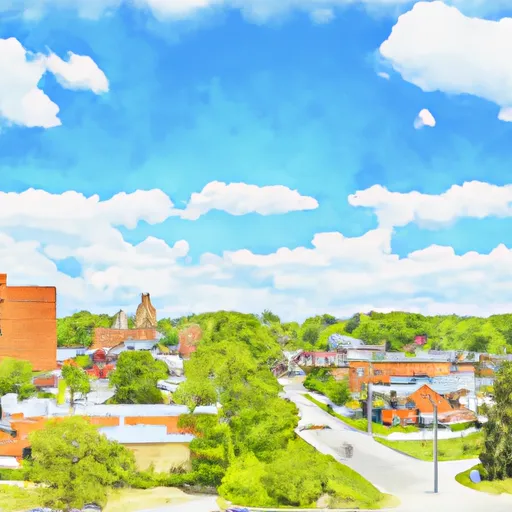-
 Snoflo Premium
Snoflo Premium
Get unlimited access to all our content
With no Ad interruptions! - Start Your Free Trial Login with existing account
Ithaca
Eden Index
Climate
8.5
•
Recreation
1.7
•
Community
2.6
•
Safeguard
4.7/10

Ithaca, Michigan is a small town located in the central part of the state. It experiences a humid continental climate with warm summers and cold winters. The average high temperature in July is around 82°F (28°C), while January temperatures average around 30°F (-1°C). Precipitation is evenly distributed throughout the year, with an annual average of 32 inches (81 cm) of rainfall, including snow during the winter months.
The hydrology of Ithaca is influenced by the nearby Pine River, which flows through the town and offers opportunities for water-based activities such as fishing, kayaking, and canoeing. The river is known for its diverse fish population, including smallmouth bass, northern pike, and various species of panfish.
In addition to the Pine River, Ithaca is surrounded by several parks and natural areas, providing outdoor recreation opportunities. The Gratiot-Saginaw State Game Area, located northwest of the town, offers hunting, fishing, and wildlife viewing. Lake Isabella, situated to the south, provides opportunities for boating, swimming, and fishing. Additionally, the area around Ithaca features numerous trails for hiking, biking, and exploring nature.
What is the Eden Index?
The Snoflo Eden Index serves as a comprehensive rating system for regions, evaluating their desirability through a holistic assessment of climate health, outdoor recreation opportunities, and natural disaster risk, acknowledging the profound impact of these factors on livability and well-being.
Climate Health Indicator (CHI): 8.5
Ithaca receives approximately
839mm of rain per year,
with humidity levels near 79%
and air temperatures averaging around
9°C.
Ithaca has a plant hardyness factor of
5, meaning
plants and agriculture in this region thrive during a short period during spring and early summer. Most
plants will die off during the colder winter months.
By considering the ideal temperature range, reliable water supplies, clean air, and stable seasonal rain or snowpacks, the Climate Health Indicator (CHI) underscores the significance of a healthy climate as the foundation for quality living.
A healthy climate is paramount for ensuring a high quality of life and livability in a region, fostering both physical well-being and environmental harmony. This can be characterized by ideal temperatures, reliable access to water supplies, clean air, and consistent seasonal rain or snowpacks.
Weather Forecast
Streamflow Conditions
Saginaw
Area Rivers
Saginaw
Snowpack Depths
Saginaw
Reservoir Storage Capacity
Saginaw
Groundwater Levels
Recreational Opportunity Index (ROI): 1.7
The Recreational Opportunity Index (ROI) recognizes the value of outdoor recreational options, such as parks, hiking trails, camping sites, and fishing spots, while acknowledging that climate plays a pivotal role in ensuring the comfort and consistency of these experiences.
Access to outdoor recreational opportunities, encompassing activities such as parks, hiking, camping, and fishing, is crucial for overall well-being, and the climate plays a pivotal role in enabling and enhancing these experiences, ensuring that individuals can engage in nature-based activities comfortably and consistently.
Camping Areas
| Campground | Campsites | Reservations | Toilets | Showers | Elevation |
|---|---|---|---|---|---|
| Aloha State Park | 285 | 602 ft | |||
| Black Creek - State Forest | 23 | 706 ft | |||
| Stoney Creek Trail Camp - State Forest | 10 | 767 ft | |||
| Herrick Rec Area | 70 | 806 ft | |||
| Camp Petosega | None | 673 ft | |||
| Sleepy Hollow State Park | 180 | 802 ft | |||
| Swains Lake | None | 994 ft | |||
| Maple Bay - State Forest | 38 | 600 ft | |||
| Burt Lake State Park | 300 | 610 ft | |||
| Pettit Park | 21 | 823 ft |
Nearby Ski Areas
Catastrophe Safeguard Index (CSI):
The Catastrophe Safeguard Index (CSI) recognizes that natural disaster risk, encompassing floods, fires, hurricanes, and tornadoes, can drastically affect safety and the overall appeal of an area.
The level of natural disaster risk in a region significantly affects safety and the overall livability, with climate change amplifying these risks by potentially increasing the frequency and intensity of events like floods, fires, hurricanes, and tornadoes, thereby posing substantial challenges to community resilience and well-being.
Community Resilience Indicator (CRI): 2.6
The Community Resilience Indicator (CRI) recognizes that education, healthcare, and socioeconomics are crucial to the well-being of a region. The CRI acknowledges the profound impact of these elements on residents' overall quality of life. By evaluating educational resources, healthcare accessibility, and economic inclusivity, the index captures the essential aspects that contribute to a thriving community, fostering resident satisfaction, equity, and social cohesion.

